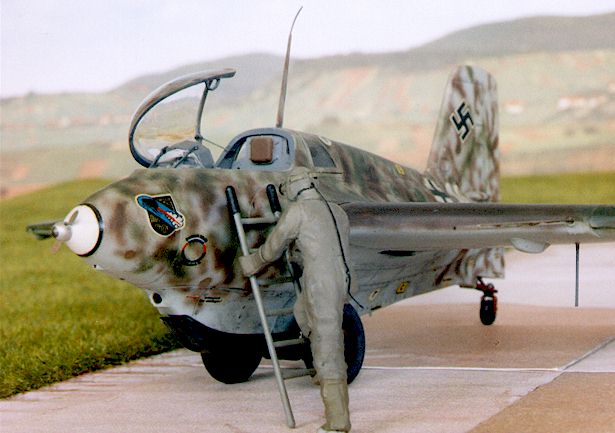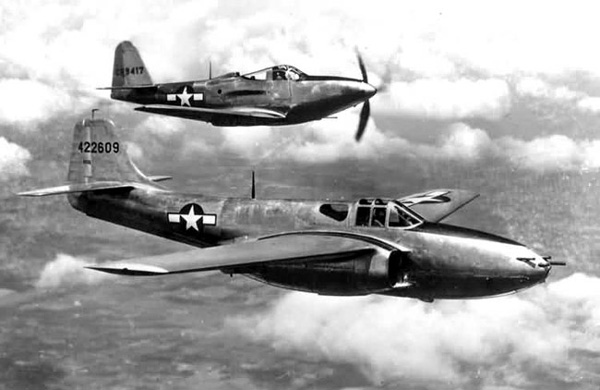Christopher Priest's book The Separation [Priest, 2002] is an alternate history with multiple layers. Alternate histories typically build on the premise that one single, but important, thing has been changed relative to “our” universe and the author then attempts to draw out the consequences of that. But, as noted by Christie [1944], everything that happens is the consequence of lots of other things that happened before that so rarely can you just posit that a single thing changed, but other things will have changed as well.
In this review I will, in the spirit of Carter [1985], pick up a throwaway line from the book and speculate over what other changes in the alternate universe had to have taken place in addition to the explicitly stated changes. The passage in question is the following:
Kurt Hofmann was a civilian test pilot working for the Messerschmitt company at a small airfield in eastern Germany. On May 10, 1941, under conditions of immense secrecy, Hofmann piloted the maiden flight of a revolutionary new type of aircraft. It was an experimental fighter powered by as jet turbine engine. The prototype Messerschmitt Me-163 flew at 995 kph (621 mph) before landing safely. This aircraft was widely used on the Russian Front from late in 1943 until the end of hostilities, becoming the standard ground-attack fighter-bomber, It was found to be superior not only to early marques of the Russian MiG-15 jet fighter, but also to the North American Sabre that was entering serviced with the USAAF at the same time.
Now, to work out the differences to our version of the universe, let us just enumerate the superficial differences and then think about the possible reasons for these.
In our universe the Me 163 was a rocket-powered interceptor. It was first flown under rocket power at the large testing site in Peenemünde by well-known test pilot Heini Dittmar; in July 1941 according to Green [1971], on August 13 according to Anderton [1975].
The F-86 Sabre was first flown in October 1947 and the MiG-15 in December the same year [Anderton, 1975], by which time the United States Army Air Forces had become the independent United States Air Force.
 So, to start with the Me 163. Clearly what is described is a completely different aircraft. “Our” Me 163 was a diminutive aircraft with a rocket engine with very limited endurance, able to reach great altitude in very short time. Merely redesigning it to use a jet engine would change the design quite considerably, at the very least requiring air intakes and ducts for the engine—or more likely, for two engines. To turn it into a (successful) ground attack aircraft would require a larger aircraft, carrying more fuel, ordinance and, not least, armour. In fact, we would probably end up with something similar to the Me 262, which aircraft is not mentioned in the passage above, though it was considerably more successful in our timeline.
So, to start with the Me 163. Clearly what is described is a completely different aircraft. “Our” Me 163 was a diminutive aircraft with a rocket engine with very limited endurance, able to reach great altitude in very short time. Merely redesigning it to use a jet engine would change the design quite considerably, at the very least requiring air intakes and ducts for the engine—or more likely, for two engines. To turn it into a (successful) ground attack aircraft would require a larger aircraft, carrying more fuel, ordinance and, not least, armour. In fact, we would probably end up with something similar to the Me 262, which aircraft is not mentioned in the passage above, though it was considerably more successful in our timeline. Perhaps the explanation is that in the Separation universe the Me 163 is in fact identical to our Me 262 and the rocket interceptor was never built.
Perhaps the explanation is that in the Separation universe the Me 163 is in fact identical to our Me 262 and the rocket interceptor was never built.This in turn requires some other things to change. Our Me 262 was not ready to fly under jet power until July 1942 after a protracted design process [Morgan and Weal, 1995]. A jet fighter had flown already in April 1941, the Heinkel 280, but neither it nor the Messerschmitt design got the necessary support from the Reichsluftfahrtministerium [Green, 1970]. The Heinkel design was killed outright and the Me 262 was not a priority project until 1944 or so. Apparently, in the Separation universe, key persons at RLM were more visionary. This would imply, in my mind, that Ernst Udet never became Generalluftzeugmeister or resigned from the post fairly soon. The question is who would replace him. It would have to be a person who would both have the organisational skills to run the technical office of RLM as well as the political skills to stand up to Göring. People such as these would be few and far between in the immediate pre-war Germany. Perhaps Ernst Heinkel could have been one of these, but what would he have been offered to take up this job, instead of his own industry? And would he have been impartial enough to award design contracts to Messerschmitt, one of his hardest competitors? Maybe this could have been achieved if the RLM had been organised more along the principles of the British Ministry of Aircraft Production, more focused on working together for a common cause than backstabbing each other, but this seems to have been utterly antithetical to the very soul of Nazi Germany. But, maybe things will work just by luck and accident, so that Germany has a technically skilled and visionary Generalluftzeugmeister who prioritises the development of a next generation of combat aircraft and that Germany manages to import the metals needed for the exotic alloys necessary for efficient jet engines. They would have to come via neutral countries, perhaps Sweden will increase its trade with Germany and in exchange receive more German military material. There could have been Bf 109s flying in the Swedish air force!
 So, with some probability we could imagine German jet fighters actually in service by 1943. Now, what about the MiG-15 and the Sabre? In our time-line they are both second-generation jet aircraft, based on aerodynamics data collected in Germany after the war by the Allies. However, as noted above, we do not have to assume that the planes in the Separation universe match the aircraft with the same names in our timeline, so they could in fact correspond to early Soviet and US jet aircraft designs, such as the Lavochkin La-15 and the Bell P-59 Airacomet, both of which would have been outperformed by almost any German jet aircraft design.
So, with some probability we could imagine German jet fighters actually in service by 1943. Now, what about the MiG-15 and the Sabre? In our time-line they are both second-generation jet aircraft, based on aerodynamics data collected in Germany after the war by the Allies. However, as noted above, we do not have to assume that the planes in the Separation universe match the aircraft with the same names in our timeline, so they could in fact correspond to early Soviet and US jet aircraft designs, such as the Lavochkin La-15 and the Bell P-59 Airacomet, both of which would have been outperformed by almost any German jet aircraft design.Anderton, David. 1975. Jet Fighters, Phoebus Publishing, Ltd.
Carter, Paul. 1985. “The Constitutional Origins of Westly v. Simmons”. Analog Science Fiction/Science Fact (CV)10, October 1985, pp 86–96.
Christie, Agatha. 1944. Towards Zero, Collins.
Green, William. 1970. Warplanes of the Third Reich, Doubleday & Company, Inc.
Green, William. 1971. Rocket Fighter, Random House, Inc.
Morgan, Hugh and Weal, John. 1995. German Jet Aces of World War 2, Osprey Publishing, Ltd.
Priest, Christopher. 2002. The Separation, Scribner.

6 comments:
Interesting! I'm thinking about the name swaps you suggest. They would presuppose pretty large-scale changes upstream too, because names are never haphazard. Most obviously, you're unlikely to have a Mk III of something before there's been a Mk II.
Well, it is somewhat more complicated than that. In the German aviation industry, for example, number blocks were allocated to manufacturers. If numbers were unused, due to a project being cancelled, for example, they might be reallocated to someone else. So a case in point is the Messerschmitt Me 163, which overtook the number from an earlier Messerschmitt Bf 163 project that never went into production. It would not have been impossible for what became the 262 project to have instead been assigned that number if the rocket-163 had been cancelled.
The MiG works on their part, for some reason only use odd numbers for their aircraft. We could imagine that there had been some projects that were cancelled in favour of high-priority production of a new jet-powered fighter to counter the German threat.
So, yes, there would be changes, but perhaps not dramatic after all.
BTW, we're waiting four your write-up of the Welsh beach find.
OK, I'll see what I can do.
Oh, and pertaining to your original comment, Spitfire Mk II did indeed precede the single Mk III, but Mk V was produced before Mk IV, Mk IX before Mk VIII, and Mk XIX before Mk XVIII.
You say "produced" -- I suppose Mk IV must have been designed before Mk V, then?
My sources do not tell, but presumably, yes. (I'm sure I can come up with examples where the design process was not in numerical order either, if I think a bit more :-)
Post a Comment